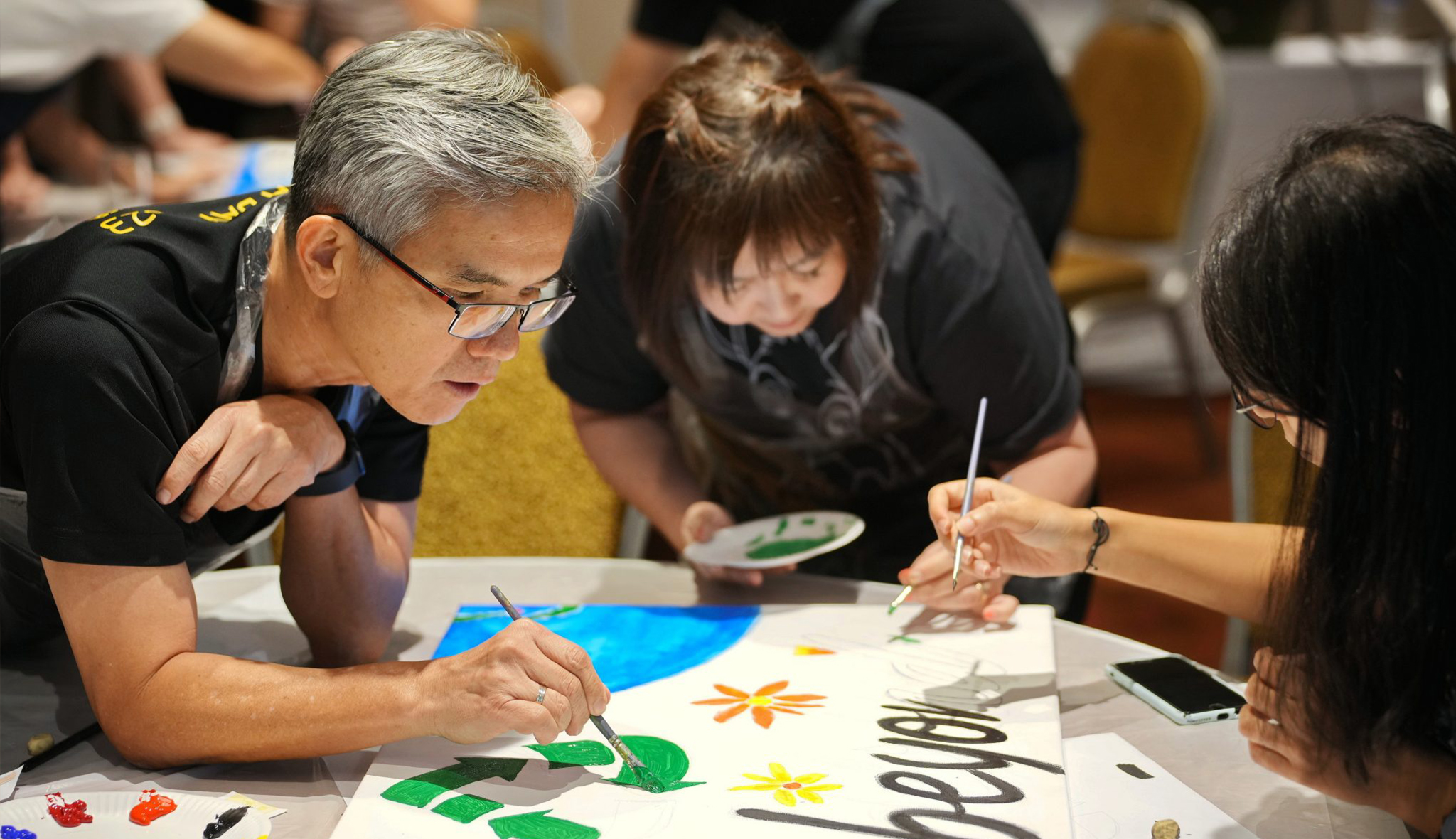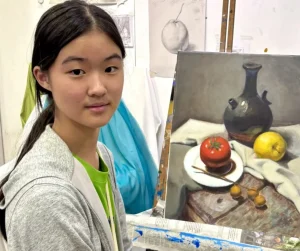Acrylic Painting on Canvas Team Bonding Art Jamming Singapore Visual Arts Centre
























Have you ever dreamed of learning professional manga drawing but didn’t know where to begin? At the Visual Arts Centre, we offer comprehensive 8 and 12-session courses designed to help you master manga drawing. Whether you’re captivated by Japanese Manga or Korean Manhwa, we tailor the lessons to suit your interests. Plus, you’ll get the chance to explore using markers or even watercolor to bring your manga or manhwa artwork to life! Let us guide you on your journey to creating stunning manga art!
So, what is Manga and why has it garnered so much interest?
Manga (漫画) is a style of comic or graphic novel originating from Japan. It encompasses a wide variety of genres and themes, appealing to readers of all ages. Manga is typically characterized by its distinct art style, which often includes expressive characters, dynamic panel layouts, and detailed backgrounds.
Manga is a cultural phenomenon, inspiring anime, live-action productions, and merchandise. It serves as a medium for storytelling, creativity, and exploring social themes.

Example of Japanese Manga

Example of Korean Manhwa
After understanding the key features of Japanese Manga, now you may be wondering what are the key differences between Japanese Manga and Korean Manhwa? It is separated into 5 different pointers from the art style, character design to layout, format and even the cultural influences.
1. Art Style and Character Design
Japanese Manga
Korean Manhwa
2. Layout and Format
3. Storytelling and Pacing
4. Color and Art Techniques
5. Cultural Influence
Summary
Both styles offer unique experiences and cater to different preferences, whether you enjoy the contemporary, digital appeal of webtoons or the detailed, traditional approach of manga.

Japanese Manga (Animation)
Learning manga drawing at the Visual Arts Centre can be a fantastic choice for anyone passionate about manga art. Here’s why:
1. Full Professional Guidance
The Visual Arts Centre provides professional instructors experienced in manga drawing techniques. They guide you step-by-step in mastering both the art style and storytelling aspects unique to manga.
2. Comprehensive Courses Curriculum
The courses cover all the essentials
At the Visual Arts Centre, you’ll receive assignments to practice at home, helping to reinforce what you’ve learned and further develop your skills through additional training.
By learning manga drawing at the Visual Arts Centre, you gain the knowledge, confidence, and creativity to bring your manga stories to life!

A student in the process of sketching Japanese Manga.

A student with her completed Manga artwork with colour pencils and markers.
This comprehensive course is perfect for beginners eager to dive into the exciting world of manga drawing. Step by step, you’ll learn the essential skills and techniques to create your manga characters, scenes, and stories—all through traditional art methods!

A student with her completed Manga artwork with watercolour.

A student with her completed Manga artwork with colour pencils.
1. Introduction to Manga Art
Understand what makes manga unique, from art styles to storytelling techniques.
Learn about tools and materials used in traditional manga drawing, such as pencils, pens, and screen tones.
2. Basic Drawing Techniques
3. Dynamic Poses and Anatomy
In manga drawing, understanding anatomy and how to depict characters in dynamic, natural poses is crucial for creating lively, believable artwork. Here’s how you can enhance your skills:
4. Inking and Line Art
Learn how to create clean and precise line art using traditional inking tools.
Explore techniques for varying line thickness to add depth and emphasis.
Use hatching, cross-hatching, and gradient shading to add dimension and texture.
Apply traditional screentones to enhance your illustrations and create dramatic effects.

A student applying watercolor to her Manga artwork.
After completing this 12-session course, you’ll have a solid foundation in manga drawing, and there are plenty of next steps to continue your growth:
1. Advanced Techniques in Manga Art
2. Manga Storytelling and Narrative
3. Digital Manga Drawing (Optional)
With ongoing practice and exploration, you’ll continue improving and expanding your manga skills, whether you aim to create your own series or just enjoy the art form!





Digital Manga Drawing guided by our instructor on IPad’s Procreate
Our student using Procreate on IPad to sketch out her reference
Introducing the Professional Manga Drawing & Digital Painting Course [12 Sessions], designed to equip students with a solid foundation in manga drawing and painting while introducing them to digital drawing and painting techniques.
As part of the 6 sessions of traditional medium, students will create artworks with markers and watercolour, with all necessary art materials provided by our studio.
Following which, the digital art segment utilizes iPad, Apple Pencil, and the Procreate application. Covering the basics of digital drawing and painting, students will learn how to use these tools to bring their manga creations to life with the help of the different tools available on the digital drawing softwares.


Our Freehand Manga Drawing is perfect for Children (Above 8 years old), Teenagers and Adults!
Manga or known as novel comic, narrates stories through graphics. Manga is inspired by true stories and sometimes presented with some transformation, exaggerations, personification, symbolism or reflection. Manga can spark a range of emotions amongst its readers – from feeling entertained to enlightened.
Manga can also be utilised as an effective way of expressing your thoughts and emotions through art, instead of the regular text form.





Our students completing their freehand manga drawing of their choice!
Children who start to draw at a young age are prone to draw humans in cartoon forms. Why not allow them to try Visual Art Centre’s professional Manga Drawing course? We cater to all beginners and children looking for improvement in their manga drawings – especially for those with a keen interest for character design.

Our Student practicing manga drawing features
Within the course objective, they will learn to draw human figure proportion, character dynamics, character drawing in digital form Computer Graphics Processing etc., all with the help of the myriad of digital softwares that are available in the market today.
The combination of foundational training on both traditional drawing and digital painting tools usage would produce more attractive artworks. Having skills in traditional drawing and digital painting would help to lay solid foundations for a future career as an illustrator / manga cartoonist / cinematic producer / interior designer/ fashion designer / animator / game art designer etc! Join us as we help you in leaning a step nearer to your aspirations!
Throughout the 12 sessions, you will will be engaged in:


Unleash your creativity and bring characters to life through costume design! In this workshop, participants will learn how to conceptualize and create costumes that reflect their characters’ personalities, story backgrounds, and worlds. You’ll explore different fashion styles, materials, and cultural influences to craft unique and visually stunning costumes.
Character Costume Design involve visually expressing who the character is and how they fit into their world, helping the audience understand the character without needing much dialogue or explanation.
Schedule:
Monday 7.30pm-9.45pm
Thursday 3.30pm-5.45pm
Saturday 6.30pm-8.45pm


Traditional manga drawing and illustration involve creating artwork by hand, using pencils, inks, and other traditional media. Artists focus on mastering techniques like human figure proportions, character dynamics, and storytelling through illustrations. Traditional tools such as pens, markers, and watercolors are used to craft detailed, engaging manga characters and vibrant illustrations.
By learning traditional manga drawing techniques, students develop the skills to create dynamic characters, compelling narratives, and visually captivating panels. Mastering these methods prepares students for careers in manga, illustration, animation, and other artistic fields. Aspiring artists will bring their creative visions to life with traditional art tools, connecting with audiences through timeless hand-drawn artwork.




|
||||||||||||||||||||||||||||||||||||||||||
|
||||||||||||||||||||||||||||||||||||||||||||||||||||||||||||||||||||||


SAT |
10:30am - 12:45pm1pm - 3pm
|
SAT |
|
10:30am - 12:45pm1pm - 3pm
|
|



Course Fees:
8 Sessions $580nett (provided all arts materials)
Venue
Visual Arts Centre Dhoby Ghaut Art Studio (within Dhoby Ghaut Green Park, above Dhoby Ghaut MRT exit B- left turn)

Click and get to our WhatsApp
In the Batik Introduction Handkerchief Painting workshop, participants will learn the traditional art of batik, a wax-resist dyeing technique originating from Indonesia. The workshop begins with a brief history and overview of batik, highlighting its cultural significance and various techniques. Participants will then observe a demonstration of applying wax with tjanting tools and dyeing the fabric. Following the demonstration, each participant will design and create their own batik handkerchief, applying wax to create patterns and then dyeing their fabric. The workshop concludes with a group discussion, allowing participants to share their creations and reflect on their learning experience.